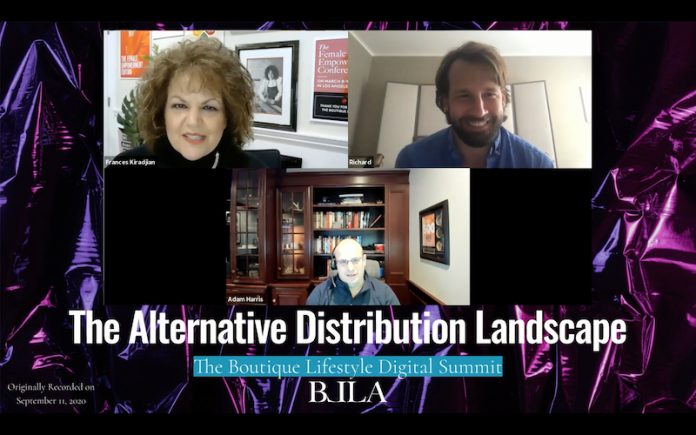
Amid the rise of OTAs and an increasingly competitive hospitality space, independent hotels have had to find ways to differentiate their marketing and distribution strategies from their branded counterparts, which often have the advantages of scale that come with being part of a larger system. That reality has not changed in the era of COVID-19—if anything, the pandemic has further highlighted the need to more effectively reach travelers who are planning trips at this time. As part of the Boutique & Lifestyle Leaders Association’s (BLLA) Boutique Lifestyle Digital Summit, which took place virtually from September 17-18, Frances Kiradjian, partner and co-founder of BLLA and StayBoutique, led a discussion with Richard Valtr, founder and director of Mews Systems, and Adam Harris, CEO of Cloudbeds, on the alternative distribution landscape, exploring how boutique hotels can target the right guests and drive bookings.
When defining an “alternative distribution,” Harris said that there is a question as to whether certain platforms—such as Airbnb, metasearch engines like Google and TripAdvisor, and even collections like The World and American Express Fine Hotels and Resorts—are considered alternative channels. “They’re all sharing a similar model at the end of the day, which is OTA-like. They’re all trying to put their hands out, get their fingers in the cookie jar,” he said.
Harris said that Cloudbeds’ approach is based on the portfolio theory—diversify into many channels. He said, internally, the company is posing the question, “Does 2 percent commission here or there matter?” The answer: “It depends,” Harris explained. “For a high-touch boutique property that has a very tight ratio of guests to staff, 2 percent might mean everything right now. For a limited-service boutique property that’s using contactless check-in and maybe doesn’t even have a front desk… 2 percent might be shared somewhere else.”
Alternative channels, he said, are just another form of intermediary between guests and properties, and signing up with Airbnb, Google, and Tripadvisor is an opportunity to pull back from giants like Booking.com and Expedia. “More mixture is going to help you level the playing field to some extent,” Harris added.
“As long as you can manage it,” Kiradjian noted. Harris agreed, adding, “That’s where systems come into play. All this can be automated these days. It’s not rocket science anymore with channel managers and seamlessly integrated systems.” Harris also noted that it’s important for hoteliers to have realtime data on their guests.
On the definition of alternative distribution, Valtr added, “You have to be where your customers are.” Valtr explained that 20 years ago when people booked hotels through brick-and-mortar travel agencies and by calling phone numbers listed in travel books and newspaper advertisements, Booking.com and Expedia may have been considered alternative providers. “There is a rapid scale of change within those last 20 or 30 years,” he said. Just as consumers shifted from booking via travel agents to OTAs, Valtr said that the next source of bookings could come from an unexpected place—for instance, he mused, a banking app with millions of customers that decides to incorporate different services. “It’s about keeping an open mind but then also looking at the statistics that you have in your system to really think about who your customer is,” he explained.
Valtr added that demand patterns and traveler behaviors are changing rapidly, especially in today’s environment. “A year ago or two years ago, you knew that your mid-weeks were going to be more business customers, your weekends were going to be leisure travelers,” he said, adding that today’s patterns are going to look different, particularly as business and event travel will be slow to recover. “If you really want to kind of come out of this much stronger, you have to get down to the nitty gritty of every single day,” he said. Think about where exactly demand is coming from, he advised, and how the property is advertising to domestic travelers who are, on average, now booking lodging just a few weeks in advance.
“It’s about actually understanding from a granular perspective where your Monday customers are coming from, where your Friday customers are coming from, and… being able to think about that distribution at scale in the quickest amount of time,” Valtr explained. With booking lead times shortening, Valtr said that hoteliers don’t have time to manually adjust rates. “That’s where the technology comes in.”
Kiradjian asked whether hoteliers should be focusing on direct bookings as a low-cost distribution. Harris said that in Cloudbeds’ portfolio, the average property in the independent asset class has a 45 percent direct booking rate. “Direct is where you have the opportunity to shine—it’s your brand, they’re interacting directly with you. You can tell your story… and you don’t have to have someone interfere with that experience,” he said. Tools like SquareSpace and Instagram allow hoteliers to better connect with guests and “reinforce a brand persona,” he said. However, direct reservations are not necessarily always cheaper, Harris added. “Properties lose sight of all of the infrastructure that goes into accommodating a direct reservation,” he explained, like costs associated with staffing someone to take reservations by phone and the expense of website creation, updates/redesigns, and maintenance.
“I like to argue: Find the guest that you love to receive. If it’s a three-night stay and they’re from Montana, go talk to them as much as possible. If they’re the most profitable, focus on them. Once you understand your story, just tell more of them and keep recreating them,” Harris said.
Valtr said that direct is best for being able to showcase the aspects that make a hotel stand out. But to stand out on OTAs, Valtr said that hotels need to use every tool in their arsenal—photography, video, Instagram, etc.—to tell their brand story, and those tools are now more accessible and affordable than ever. “In this day and age, if you don’t stand out and if you just assume that the customer is basically going to find you because you’re the cheapest… that’s just not enough,” he said. Start with understanding the customer, who you want to attract, and how you’re going to persuade them to come to your website to book direct, he added.
Harris said that hotels should take advantage of opportunities to differentiate within distribution channels—like Booking.com’s recently launched filter for properties that have implemented health and safety initiatives. “I also think that when you take a reservation, there is a ton of opportunity to upsell that reservation as the guest is arriving… There are a lot of things we can do along the guest journey to help create better first impressions,” he added, like automated systems that help upsell after a guest arrives. “Those little things mean you can inch back closer to that RevPAR that you were ultimately loving back in 2019.”
When considering incorporating third-party systems, Valtr said that hoteliers should look for technology that has open APIs; real-time connectivity (“Speed is of the essence,” he said); and automation. “Go for systems that think in automatic ways so that you can handle an online check-in/check-out in the speediest possible way. Also think about non-traditional ways to connect,” Valtr advised. “You have to think about it from the perspective of, ‘I will meet my customers where they are, not where they were traditionally.'”











